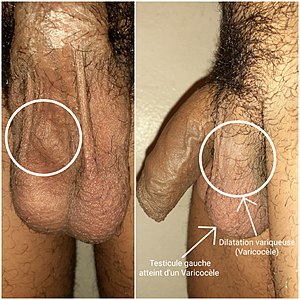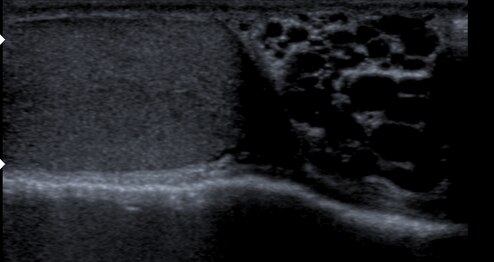Varicocele
| Varicocele | |
|---|---|
 | |
| Varicocele on the person's left testicle. Notice the swelling and slight enlargement of the left testicle, which is marked by an arrow. | |
| Pronunciation | |
| Specialty | Urology |
A varicocele is an abnormal enlargement of the pampiniform venous plexus in the scrotum. This plexus of veins drains blood from the testicles back to the heart. The vessels originate in the abdomen and course down through the inguinal canal as part of the spermatic cord on their way to the testis. Varicoceles occur in around 15% to 20% of all men.[3][4] The incidence of varicocele increase with age.
Signs and symptoms[]
Varicocele might be noticed as soft lumps, usually above the testicle and mostly on the left side of the scrotum.[5] Right-sided and bilateral varicocele does also occur. Men with varicocele can feel symptoms of pain or heaviness in their scrotum.[5] Large varicoceles present as plexus of veins and may be described as "bag of worms".[6][7] Varicocele is sometimes discovered when investigating the cause of male infertility.[8][9]
Cause[]

There are three main theories as to the anatomical cause; the first has to do with the geometry of the veins, wherein the vein on the left side connects to the larger outflowing vein at a right angle, which tends to fail; the second is that valves that are supposed to prevent backflow fail (venous insufficiency); the third is due to excessive pressure in upstream arteries, created by nutcracker syndrome.[10]
Pathophysiology[]
Often the greatest concern with respect to varicocele is its effect on male fertility. The relationship between varicocele and infertility is unclear. Some men with the condition are fertile, some have sperm that are normal in shape and move normally but are compromised in function, and some have sperm with abnormal shapes or that do not move well.[10] Theories as to how varicocele affects sperm function include damage via excess heat caused by the blood pooling and oxidative stress on sperm.[4][10][11][12]
Tobacco smoking and mutations in the gene expressing glutathione S-transferase Mu 1 both put men at risk for infertility; these factors may also exacerbate the risk that varicocele will affect fertility.[10]
Diagnosis[]
Following discovery of the sign of swelling comprising a mass, varicocele can be confirmed with scrotal ultrasound, which will show dilation of the vessels of the pampiniform plexus to be greater than 2 mm.[13]

Varicocele in ultrasound (left: testicle)

Varicocele
Treatment[]

The two most common surgical approaches are retroperitoneal (abdominal using laparoscopic surgery), infrainguinal/subinguinal (below the groin) and inguinal (groin using percutaneous embolization).[4] Possible complications of this procedure include hematoma (bleeding into tissues), hydrocele (accumulation of fluid around the affected testicle), infection, or injury to the scrotal tissue or structures. In addition, injury to the artery that supplies the testicle may occur, resulting in a loss of a testicle.[4]
Prognosis[]
Whether having varicocele surgery or embolization improves male fertility is controversial, as good clinical data is lacking.[9] There is tentative evidence that varicocelectomy may improve fertility in those with obvious findings and abnormal sperm;[4] however, this has a number needed to treat of 7 for varicocelectomy and 17 for embolization.[14][15] There are also studies showing that the regular surgery has no significant effect on infertility.[9] A 2012 Cochrane review (updated in 2021) found tentative but unclear evidence of improved fertility among males treated for varicocele.[16] Evidence for sclerotherapy is unclear as of 2015.[17]
Epidemiology[]
Around 15% to 20% of all adult males, up to 35% to 40% of men who are evaluated for male infertility, and around 80% of men who are infertile due to some other cause, have varicocele.[3][4][9]
References[]
- ^ "Varicocele". Merriam-Webster Dictionary. Retrieved 2016-01-21.
- ^ "Varicocele". Oxford Dictionaries UK Dictionary. Oxford University Press. Retrieved 2016-01-21.
- ^ Jump up to: a b White, Wesley M.; Kim, Edward David; Mobley, Joe D (2 January 2019). "Varicocele: Epidemiology". Medscape. Retrieved 18 September 2019.
Although varicoceles appear in approximately 20% of the general male population, they are much more common in the subfertile population (40%).
- ^ Jump up to: a b c d e f Kupis, Ł; Dobroński, PA; Radziszewski, P (2015). "Varicocele as a source of male infertility - current treatment techniques". Central European Journal of Urology. 68 (3): 365–70. doi:10.5173/ceju.2015.642. PMC 4643713. PMID 26568883.
- ^ Jump up to: a b "Testicular lumps and swellings - Causes - NHS Choices". NHS Choices. 7 October 2014.
- ^ Cannarella, Rossella; Calogero, Aldo E.; Condorelli, Rosita A.; Giacone, Filippo; Aversa, Antonio; La Vignera, Sandro (8 September 2019). "Management and Treatment of Varicocele in Children and Adolescents: An Endocrinologic Perspective". Journal of Clinical Medicine. 9 (8): 1410. doi:10.3390/jcm8091410. PMC 6780349. PMID 31500355.
- ^ Leslie, Stephen W.; Sajjad, Hussain; Siref, Larry E. (7 October 2019). Varicocele. StatPearls [Internet]. Retrieved 20 January 2020.
- ^ "Low sperm count". NHS Choices. 2 August 2016.
- ^ Jump up to: a b c d Baazeem, Abdulaziz; Belzile, Eric; Ciampi, Antonio; Dohle, Gert; Jarvi, Keith; Salonia, Andrea; Weidner, Wolfgang; Zini, Armand (2011-10-01). "Varicocele and male factor infertility treatment: a new meta-analysis and review of the role of varicocele repair". European Urology. 60 (4): 796–808. doi:10.1016/j.eururo.2011.06.018. PMID 21733620.
- ^ Jump up to: a b c d Eisenberg, Michael L.; Lipshultz, Larry I. (2011-01-01). "Varicocele-induced infertility: Newer insights into its pathophysiology". Indian Journal of Urology. 27 (1): 58–64. doi:10.4103/0970-1591.78428. ISSN 0970-1591. PMC 3114589. PMID 21716891.
- ^ Hayden, Russell P.; Tanrikut, Cigdem (2016-05-01). "Testosterone and Varicocele". The Urologic Clinics of North America. 43 (2): 223–232. doi:10.1016/j.ucl.2016.01.009. ISSN 1558-318X. PMID 27132580.
- ^ Dabaja, Ali; Wosnitzer, Matthew; Goldstein, Marc (2013-08-01). "Varicocele and hypogonadism". Current Urology Reports. 14 (4): 309–314. doi:10.1007/s11934-013-0339-4. ISSN 1534-6285. PMID 23754533. S2CID 5477034.
- ^ Salam, MA (2013). Principles and Practice of Urology. New Delhi 110 002, India: Jaypee Brothers Medical Publishers. p. 752. ISBN 978-93-5025-260-4.CS1 maint: location (link)
- ^ Kroese, A. C. J.; Lange, N. M. de; Collins, J. A.; Evers, J. L. H. (2013-07-01). "Varicocele surgery, new evidence". Human Reproduction Update. 19 (4): 317. doi:10.1093/humupd/dmt004. PMID 23515200.
- ^ Li, Fuping; Yue, Huanxun; Yamaguchi, Kohei; Okada, Keisuke; Matsushita, Kei; Ando, Makoto; Chiba, Koji; Fujisawa, Masato (2012). "Effect of surgical repair on testosterone production in infertile men with varicocele: A meta-analysis". International Journal of Urology. 19 (2): 149–54. doi:10.1111/j.1442-2042.2011.02890.x. PMID 22059526. S2CID 20329833.
- ^ Persad, Emma; O'Loughlin, Clare Aa; Kaur, Simi; Wagner, Gernot; Matyas, Nina; Hassler-Di Fratta, Melanie Rosalia; Nussbaumer-Streit, Barbara (2021-04-23). "Surgical or radiological treatment for varicoceles in subfertile men". The Cochrane Database of Systematic Reviews. 4: CD000479. doi:10.1002/14651858.CD000479.pub6. ISSN 1469-493X. PMID 33890288.
- ^ Macleod, R; Biyani, CS; Cartledge, J; Eardley, I (13 July 2015). "Varicocele". BMJ Clinical Evidence. 2015. PMC 4500994. PMID 26168774.
| Classification | |
|---|---|
| External resources |
- Andrology
- Male genital disorders
- Scrotum
- Vascular diseases

